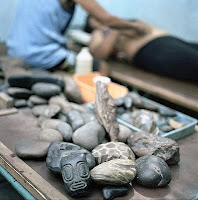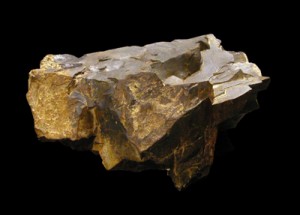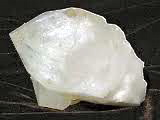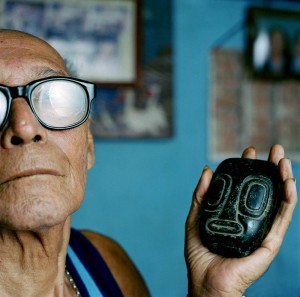 |
| Vance Gellert, Victor Ventos’ Stones (2005) |
Significant among the tools used by shamans in the Upper Amazon are piedras, or piedras encantadas, magic stones, sometimes called just encantos, charms; such stones are called inkantos by the Machiguenga and Shipibo. My teacher doña María Tuesta told me that her father was a tabaquero who kept two magic stones, one male and one female, in a jar filled with a mixture of tobacco and water. When doña María was about eight years old, while her father still lived with the family, she saw him work with the stones twice. She could see the spirits of the stones: they both had very dark skin and long black hair. The male spirit of the stone had dark red eyes like huayruro seeds. His mouth was painted red, the color of brujería, sorcery — magia roja, red magic, the worst kind. He could stick his tongue out all the way to his chest, as is typical of sorcerers; his flema, magical phlegm, was filled with scorpions, snakes, and toads.
In addition, doña María, in the dream journey that constituted her coronación as a prayer healer, dreamed that she passed by a stream in which piedritas, magical stones of all kinds, large and small, were singing to her: “Welcome, welcome, maestra, doctora.” Doña María counted such magic stones among her animal protectors, since the imanes, spirits, of the stones became black boas, yellow boas, condors, and macaws in order to protect her.
 |
| Black flint |
Magic stones may — but need not be — striking in appearance: color, shape, and texture may indicate that a stone is, in fact, encantada. The stone may be shaped like a person or animal, like a snake or a jaguar claw, or have an unusual color, or be visually attractive, or just be rare. The stone may turn up in an unusual place or behave oddly; among the Aguaruna, a magic stone is often found in the stomach or crop of an animal as it is being cleaned. The stone may speak to the shaman, or the spirit of the stone may appear in the shaman’s dreams, or in an ayahuasca vision. Cocama shaman don Juan Curico says that encantos are stones that with time have taken the shape of jungle animals or human body parts. He himself has stones in the shape of a snail, the head of an anaconda, the head of a crocodile, a human hand and head.
Crystals particularly are prized; they are, says one mestizo shaman, luz solidificada, solidified light, with a celestial origin. Ordinary piedra pedernal, flint — “like a crystal, but black,” doña María explained to me — may be a powerful magic stone, perhaps in part because it is not native to the Amazon. Such stones come from Lima, I was told; they are about three inches long. If you put the stone in a glass jar of water, and then drink the water, the stone takes away shame, sorrow, anxiety.
The doctrine of signatures applies to stones as well as to plants. Don Francisco Montes Shuña says that a shaman can tell what stones have power, and what power they have, by looking at their shape and color. A stone of white marble can be an arcana, protection, because it purifies, cleanses, and protects the body; a red stone can nourish the blood; translucent crystals give vision and clarity. A stone in the shape of a human hand can take away pain from the body part on which it is placed.
 |
| Crystal |
Magic stones will stick for several hours to the place on the body where sorcery has struck, suck out the harm — the dart, the insect, the scorpion, the phlegmosity — and then drop off. Stones can also be used to rub the place where the sickness is located, to loosen the intrusive pathogenic object, so that the shaman can suck it out from the suffering flesh.
Just as the shaman drinks the plants in order to master them, the shaman drinks the magic stones. The shaman leaves the stones in water for a day, observing la dieta, blowing tobacco smoke over them, telling the stone what the shaman wants to know, and finally drinking the water. The spirit of the stone will then appear in a dream and teach the shaman what the shaman seeks. The spirit of the stone can also be seen when drinking ayahuasca; the stones can also be kept in a tobacco infusion, and the tobacco drunk. “It is something admirable,” says don Juan Curico, “to share the wisdom of millions-year-old beings.”
Beliefs about magic stones are widespread in the Upper Amazon. Among the Waiwai, a magic stone, called ñukwa, appears in the mouth of the apprentice shaman during a dream; holding the stone in his mouth, the apprentice learns to sing the magic songs. Similarly, Warao shamans acquire magic stones which descend into their mouths during dreams. Among the Aguaruna, magic stones are generally used for a variety of purposes — hunting, seduction, planting, warfare. These stones have souls, and can assume human form in dreams; they can drink blood, eat souls, and run away if not properly fed. Rock crystals among the Desana are invested with complex cosmological and sexual symbolism. The stones are fed on tobacco, and stored in water infusions of tobacco; these nicotine-rich infusions are drunk in order to communicate with the spirits of the stones.
 |
| Vance Gellert, Victor Ventos, Stone Healer (2005) |
Yagua shamans keep two kinds of magic stones — small stones called soul-stones or invisible stones, which are kept safe in the stomach; and visible stones, which are kept in a bag hung around the neck. No shaman ever shows these visible stones, saying that they would then lose their power. Blowing tobacco smoke on these stones increases their size a hundredfold. When small, they may be used as weapons, just like darts; when enlarged with tobacco smoke, they became a barrier of protection. Shamans can also keep pieces of glass, called transparent stones, in their stomach, which they can regurgitate and place in the beer gourds of their victims; when swallowed, the glass cuts up the body from the inside.
The Machigengua apprentice receives stones from an invisible celestial being who appears in the apprentice’s ayahuasca vision. The stones must be fed regularly with tobacco smoke; when they are thus nourished, they turn into jaguars. Machigengua shamans acquire these stones — light-colored or transparent, especially quartz crystals — during initiation or from the shaman’s father or other close relative. These stones are considered the body, or residence, or material manifestation of the spirits. The shaman carries the stones in a small bag and feeds the stones tobacco daily; if the shaman fails to do so, the spirits will leave the stones, and the shaman will die. Canelos Quichua believe that the spirits in their magic stones are those of dead shamans. If you gently blow on such a stone, you will see condensation appear on its surface; this shows that the stone “has breath,” that it is a powerful shaman.

- Previous Post: Fire on the Mountain
- Next Post: Entheogen: The Movie
- More Articles Related to: Ayahuasca, Indigenous Culture, Plant Medicine, Shamanism, The Amazon



Does anyone know if fossils are used as magic stones? I’m thinking of a stone called shali[a]grama (śāligrāma or śālagrāma) in India, which is a fossil ammonite. Most are very small. All come from the Kali Gandaki river basin in Nepal, a region very difficult of access. They are accorded great sanctity and assigned great magical powers. I have looked closely through a long Sanskrit manuscript on śālagrāmas. Much of what you write here, Steve, could be said for these stones as well.
Thank you for that interesting comment. Do people in India feed the stones? If so, do they feed the stones tobacco? In fact, is tobacco sacred in India at all?
Hmm. The genus Nicotiana is probably native to the Upper Amazon, and was brought to North America because it was a sacred plant. I have read speculation that tobacco may in fact have been the first cultivated crop, for the same reason. I don't see how tobacco could have reached India before, say, the sixteenth century. In Tibet, the Rnying-ma condemn tobacco — the usual Tibetan word is ta-maq, clearly a borrowing — based on a gter-ma or hidden text attributed to Padmasambhava. For that reason, I remember being surprised to see Chögyam Trungpa smoking when I first met him just about — omigod — forty years ago.
So, Fred, I can't think of anyone better equipped to satisfy my curiosity. Is tobacco sacred in India? And do they feed it to their stones?
I have not seen anyone feeding tobacco to śālagrāmas. Thee stones are "fed," certainly, because they are regarded as substitutes for Viṣṇu or Krishna, and are commonly found on altars in places such as Vrindavan. Indeed, in many places śālagrāmas receive the same offerings as the images of these deities. They are often taken by devotees when they leave their homes for a few days or weeks of travel. They are fed the usual offerings, always vegetarian, but also incense (yes, this IS considered a "feeding"). I have seen tobacco used sacramentally among certain Tantrikas in India, and I do not doubt that it has been used on śālagrāmas. But by the time tobacco arrived in India and Asia in general in the 16th century, thanks to the Portuguese, it was not considered a sacramental substance, as it was in South & North America. It has become sacramental in certain quarters, but in my experience it has drawn that quality from the occasional sacramental use of cannabis products. A question I have is the following: In your experience is the sacred nature of tobacco considered a natural property? Is it naturalized due to cultural production and use? Is it regarded as sacred only after passing through the human body, meaning that the interaction between the human body, one's consciousness, and the cut and dried tobacco yeilds a "magical" or sacramental effect? Thanks
Actually I have another question for you, Steve? What is the evidence that tobacco was brought to North America because it was sacred? Do you know when it was brought north or what the mechanism was for bringing it north? Are we certain that it was not brought north by the Europeans because it was addictive, but that the North American Indians used it sacramentally (rather than abusively) because that’s the way they used plants?
The best general resource for tobacco use in South America is Johannes Wilbert, Tobacco and Shamanism in South America (New Haven, CT : Yale University Press, 1993). Wilbert gives a number of reasons to believe that all the Nicotiana species originated in South America, although he says — now that I have looked at his chapter again — that "man has not been instrumental, voluntarily or involuntarily, in the dispersion of the genus in its wild state." [sigh] Another beautiful theory mugged by a gang of ugly facts. There is, however, no doubt at all that tobacco use was virutally universal among indigenous peoples of North America at the time of first contact with Europeans, as evidenced both by the historical record and archeological finds of pre-contact pipes.
Tobacco has a number of psychoactive effects, from mood stabilization at low doses to hallucinations at high doses. Nicotine aids concentration, inhibits MAO, and helps to ameliorate some of the negative effects of scopolamine ingestion and schizophrenia, while apparently having no effect on the hallucinatory effects of either. In the Upper Amazon, it is one of what I call the Big Three hallucinogens — ayahuasca, toé, and mapacho, which offer, resspectively, teaching, power, and protection, and whose primary effects depend in part on dimethyltryptamine, scopolamine, and nicotine, respectively.
I would guess that the sacrality of tobacco is distinctively American. It is interesting to me that tobacco is used as a hallucinogen in South America, but I have found no evidence of this use in North America. Indigenous Amazonian peoples ingest tobacco in every conceivable way — smoked, as a snuff, chewed, licked, as a syrup applied to the gums, and in the form of an enema. In North America, tobacco is ingested only by smoking in relatively low mood-stabilizing amounts.
Steve, I love your statement: “Another beautiful theory mugged by a gang of ugly facts.” Thanks for this info. This pretty clearly answers my questions. What is toé? Do you have a posting about it? Thanks
Fred —
On toé, look here and here.
so inkantos are like mother earth right?I hear there beautiful and the most beautiful voices..
Hello,
I’m facinated by the uses of stones, and by your article. It’s great. Will you write more about stones? Do you speak about them in your book? Any books, articles etc. you recommend about the shamanic uses of stones and crystals?
Regards
Josephus
You want to see a real magic stone?
http://fc02.deviantart.net/fs71/f/2010/069/f/e/eye_shadow_in_mask_by_albatrash.jpg
I found the stone in a wood. it is flint, a stone with obvious magical symbolism. The stone contains images that I had dreamt about before finding the stone. I have begun to experience odd things. Magical things.
In my last ayahuasca ceremony there was a large female spirit who gave me an intensely red stone which I swallowed without even thinking about it. It was like a natural reaction. At a certain moment, later on in the ceremony, I was moving this stone through my body and it felt like it was healing me in a certain way or at least it felt very right to move it around. I still have a feeling that this stone is inside of me and I can still move it around in the same way I did during the ceremony. This was only the second time I’ve ever drunk ayahuasca so I don’t have a lot of experience yet. After the sharing the shaman who conducted the ceremony said nothing to me about the stone and for some reason I didn’t ask him about it. Now I’m still wondering what this is and what I have to do with it. If you’ve heard of similar events or if you could provide me with some more information I would be very grateful.
Thank you anyway for your great blog!
Rik